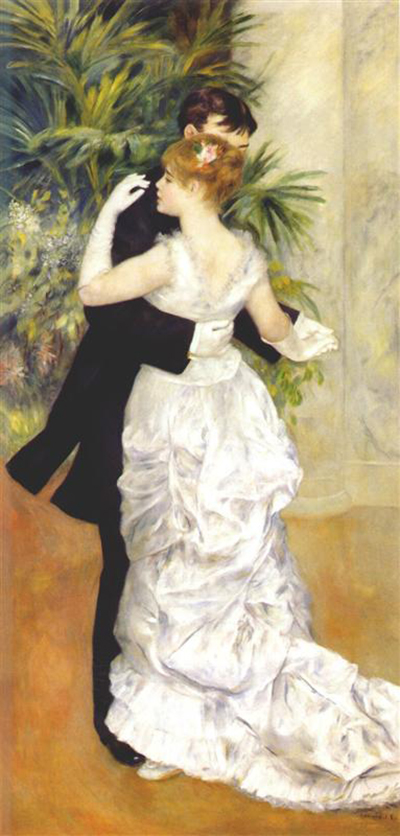One of the first things to notice about this painting is the vibrancy and skill demonstrated in the coloration of the two characters
Although Renoir wasn't keen on using models for his subjects, these are nevertheless real people depicted in a true to life setting identifiable as Paul Lhote (who featured in other paintings) and a model, Maria Clementine (who later became a painter).
Dance In The City completed in 1883 shows an intimate and carefully observed moment comprising part of a set of three paintings (Dance In The Country and Dance At Bougival).
As with Monet, Renoir liked to revisit the same subject matter and to produce different variations on a theme. The idea behind this was that each would contain a fresh element. Perhaps a change of expression or a different pose or more importantly, a change in the play of light and shade on the subject especially when out of doors.
All three canvases are almost life sized but in "Dance In The City" the emotions of the couple are more restrained.
Although Renoir's earlier works lent themselves far more to the Impressionist school, after a trip to Italy in 1881 where he observed examples of classical art, his style become more formal.
This is evident in the painting where the outlines of the two characters are sharply defined and the creases and folds in the woman's dress are very accurately painted. Skin tones are very subtly depicted using a a range of colours to reproduce as faithfully as possible the play of light.
This approach was very much in keeping with Renoir's desire to capture the beauty of women and also to highlight elements of feminine sensuality. Although the characters in the painting are fully clothed their intimate hold and the way in which their bodies appear to move as one, conveys a powerful message. Moreover, the flow of the gentleman's coat tails as he turns on his toes gives further evidence of this dynamism.
Renoir would sometimes sketch first and then complete work back at his studio but often, a complete scene would be captured and completed there and then. This was paying tribute to the Impressionist ideal of attempting to catch a particular moment in time.
The women's demure expression with its sense of being lost in the moment also gives the scene depicted a slightly erotic charge. We only see a very small part of the man's face but the way in which his arms bind the women's body to his own tells its own story. Renoir has used soft brush techniques very precisely and evenly. The plants in the background and the wall decorations have also been executed in a restrained manner giving them a proper authenticity.
Both characters in the scene blend easily with their surroundings and it is worth noting Renoir's use of black which hitherto had been mixed using other colours.
Renoir once said that: "It is not enough for a painter to be a clever craftsman, he must love to caress his canvas too". In "Dance In The City" this philosophy is more than in evidence.




